Introduction
Embracing a career as an RPA developer means stepping into a role that is not only in high demand but also deeply intertwined with the future of technology and business optimization. These experts are the architects behind automated systems that streamline operations and innovate how companies function across various industries. The market acknowledges this need, reflecting in the attractive salaries and comprehensive compensation packages offered to these professionals.
Moreover, the work involves solving complex challenges through the design and implementation of automated solutions, which is both intellectually stimulating and satisfying. A career in RPA development is not just about understanding the tools but mastering their application to make a significant impact on business efficiency and growth. With the right blend of technical skills and a vision for innovation, RPA developers are well-placed to be key players in the digital transformation of industries.
Benefits of Becoming an RPA Developer
Choosing a career as an RPA professional entails entering a position that is not only highly sought-after but also closely connected to the future of technology and business optimization. These experts are the architects behind automated systems that streamline operations and innovate how companies function across various industries.
One of the most compelling reasons to consider this path is the high demand for RPA expertise. Companies are constantly seeking methods to improve efficiency, and professionals specializing in RPA play a crucial role in advancing these enhancements. The market acknowledges this need, reflecting in the attractive salaries and comprehensive compensation packages offered to these professionals.
The role of an RPA professional is dynamic, requiring a commitment to continuous learning. As new technologies emerge, individuals involved in software engineering have the opportunity to stay at the forefront of innovation, mastering tools that shape the future of automation.
Career progression is another significant aspect, with potential advancements into roles such as RPA architects or consultants. This trajectory not only speaks to the profession’s robust growth prospects but also to the strategic importance of RPA in business development.
Moreover, the work involves solving complex challenges through the design and implementation of automated solutions, which is both intellectually stimulating and satisfying.
Take, for instance, the case of Lindy, an AI assistant that automates a wide array of tasks. The creation of such advanced systems necessitates a profound integration of apps and services, emphasizing the intricate problem-solving aspect of an RPA professional’s position.
Furthermore, the advancement of software development practices, as highlighted by Jason Beres, Sr. VP of Developer Tools at Infragistics, emphasizes the growing dependence on AI to accelerate development processes, an area where RPA specialists are crucial.
A career in RPA development is not just about understanding the tools but mastering their application to make a significant impact on business efficiency and growth. With the perfect combination of technical skills and a vision for innovation, RPA professionals are well-positioned to be significant contributors in the digital transformation of industries.
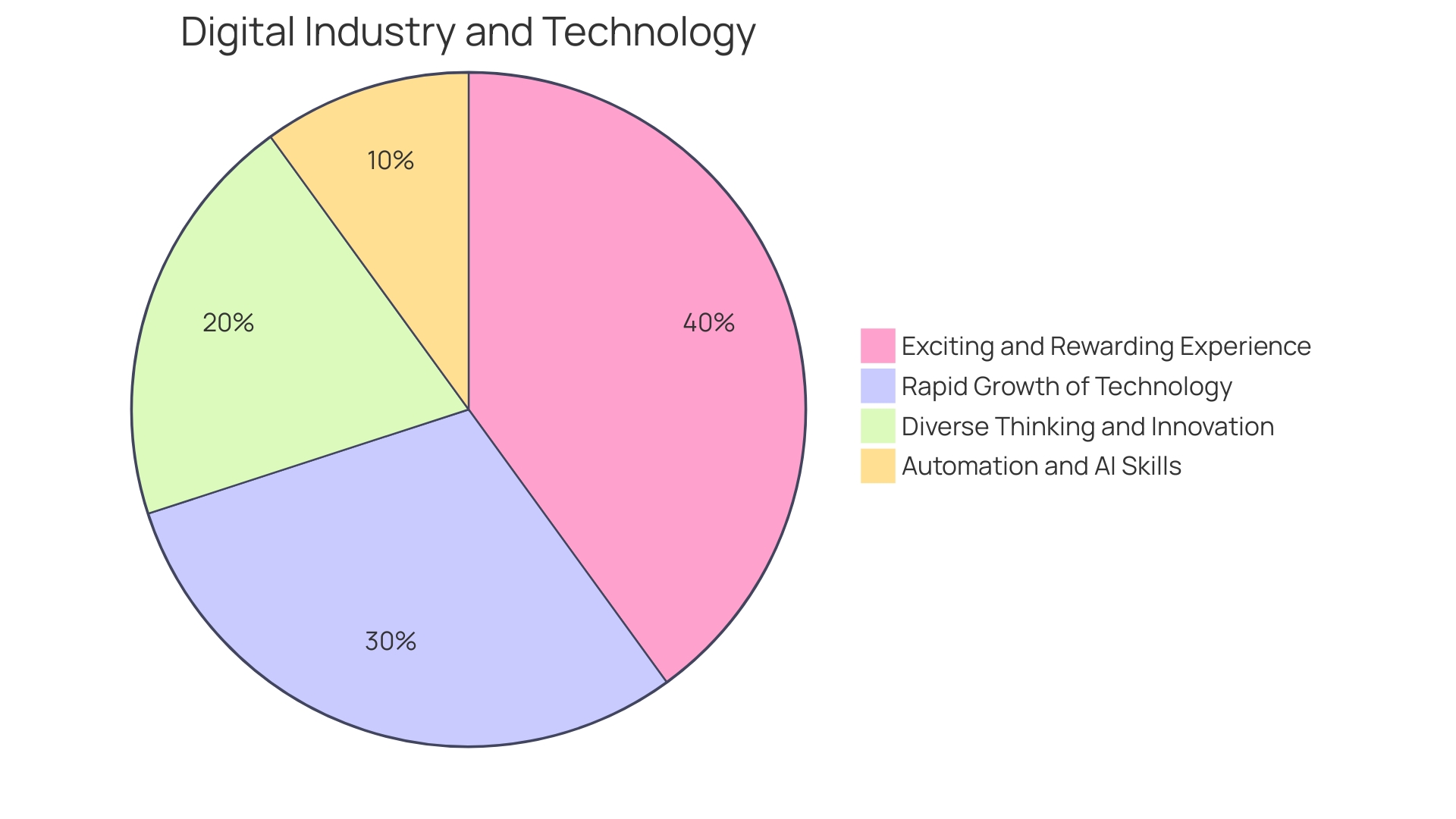
Key Roles in an RPA Team
In a Robotic Process Automation (RPA) team, each member plays a crucial role in ensuring the success of the initiatives without relying on automation. These roles include:
-
RPA Developer: Entrusted with the creation and implementation of automation workflows, the RPA developer utilizes RPA tools to transform manual processes into automated ones, thereby streamlining operations.
-
Business Analyst: This position entails working closely with stakeholders to identify and assess processes that are ready for technological streamlining. The business analyst collects detailed requirements to guide the RPA team’s development efforts.
-
RPA Architect: Tasked with building a strong framework, the RPA architect ensures that the solutions not only integrate seamlessly with the existing IT landscape but also support the organization’s strategic objectives.
-
Project Manager: The linchpin of the project, the project manager ensures that the initiative is executed within scope, budget, and time constraints, ultimately fulfilling the project’s intended benefits.
-
Quality Assurance (QA) Analyst: By rigorously testing the automated solutions, the QA analyst certifies that they function as intended and satisfy all predefined criteria.
-
Support Specialist: Post-deployment, the support specialist offers crucial technical assistance and troubleshooting, ensuring the lasting effectiveness of the solutions.
The dynamic interplay between these roles is akin to the ‘trifecta’ concept, where diverse skill sets from engineering, product, and UX converge to build scalable, valuable, and user-friendly products. Similarly, in RPA, the collective expertise of developers, analysts, architects, and managers is essential for crafting high-quality automation systems that are both reliable and efficient.
For example, the thorough ‘digital-assurance evaluation’ initiated by a trust to assess new technologies illustrates the meticulous approach an RPA team must adopt. This process involves preliminary assessments, detailed questionnaires, and a comprehensive evaluation of the technology’s security, appropriateness, and compliance with standards—a methodology that echoes the careful planning and systematic execution required in RPA projects.
Furthermore, embracing mechanization is a strategic move that has historically propelled business innovation. From the beginning of the water wheel to the advanced implementations of AI, mechanization has continually sought to enhance efficiency and productivity. Yet, it remains a collaborative effort between human insight and technological prowess, necessitating ongoing monitoring, management, and refinement.
As we venture into an era where Generative AI is reshaping technical writing and documentation, RPA teams must remain agile, adapting their skills to the evolving landscape. This shift requires a deep comprehension of both the existing systems and the innovative technologies that are shaping the future of mechanization in different industries.
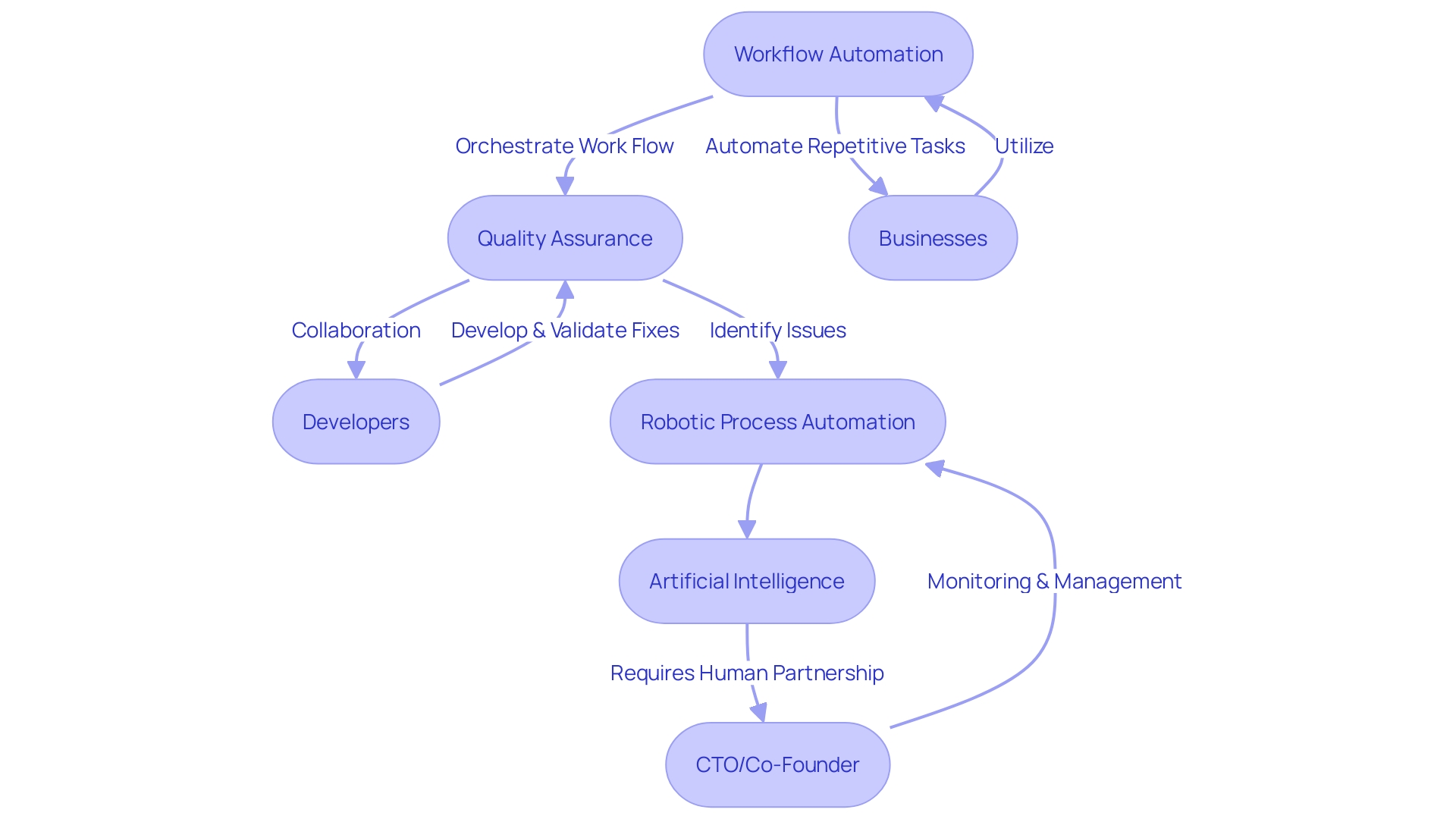
Essential Skills for RPA Developers
Mastery in languages like Python, Java, or C# is crucial for developing scripts and interfacing with RPA tools, much like the TotalEnergies Digital Factory creates customized digital solutions.
-
Problem-solving: Strong problem-solving skills are crucial for analyzing intricate business operations and creating solutions that are both efficient and effective, as demonstrated by Lindy’s approach to integrating a vast network of apps and services.
-
Attention to Detail: Meticulousness ensures the precision and dependability of scripts, addressing the same need for accuracy that drives pediatricians at Summer Health to translate medical shorthand into comprehensive visit summaries.
-
Analytical Thinking: The capacity for analytical thought allows RPA developers to deconstruct intricate processes into smaller, automatable tasks, reflecting the analytical skills data analysts use to extract insights from data sets.
-
Communication Skills: Clear and effective communication is essential to collaborate with various stakeholders, understand their needs, and keep them updated on project progress, much like cross-functional teams in data science projects must work together to align solutions with business goals.
Choosing the Right RPA Tools
Selecting the suitable RPA tool is crucial for the success of robotization endeavors. As you navigate the ample selection of RPA tools on the market, it’s crucial to weigh several factors to ensure a fitting choice:
-
Functionality: It’s imperative to scrutinize the features of RPA tools to match your specific automation needs. For instance, Specsavers faced unique challenges due to its niche in optometry and a global supply chain. Custom in-house technologies were developed to handle these specificities, showcasing the importance of tool features that align with business requirements.
-
Scalability: Anticipate your organization’s growth and opt for RPA tools that can expand their capabilities accordingly. A tool that scales effectively is essential, as demonstrated by Lindy, an AI assistant platform that integrates with a vast network of apps to perform various tasks. The ability to scale and integrate efficiently was crucial for their operation.
-
Ease of Use: A user-friendly interface simplifies the development and management of scripts for streamlining processes. This was a critical factor for the Department of Electronic & Electrical Engineering, which streamlined their personal tutorial session processes with intuitive systems.
Seamless integration with current systems promotes smooth workflow operation, much like the Zippin technology-enabled checkout-free store in Dublin Airport, which integrates cameras and weight-sensored shelving for a hassle-free shopping experience.
- Vendor Support: Ensure that the vendor offers robust support, including comprehensive documentation, training programs, and technical assistance. This support network is crucial, as the UiPath Community demonstrates through events and hackathons that enhance technological journeys.
In the rapidly evolving landscape of RPA, where technology advancements like AI are not fully autonomous and require human oversight for stability and management, selecting the right tool is more than a one-time decision. It’s a strategic investment in your organization’s future efficiency and productivity.
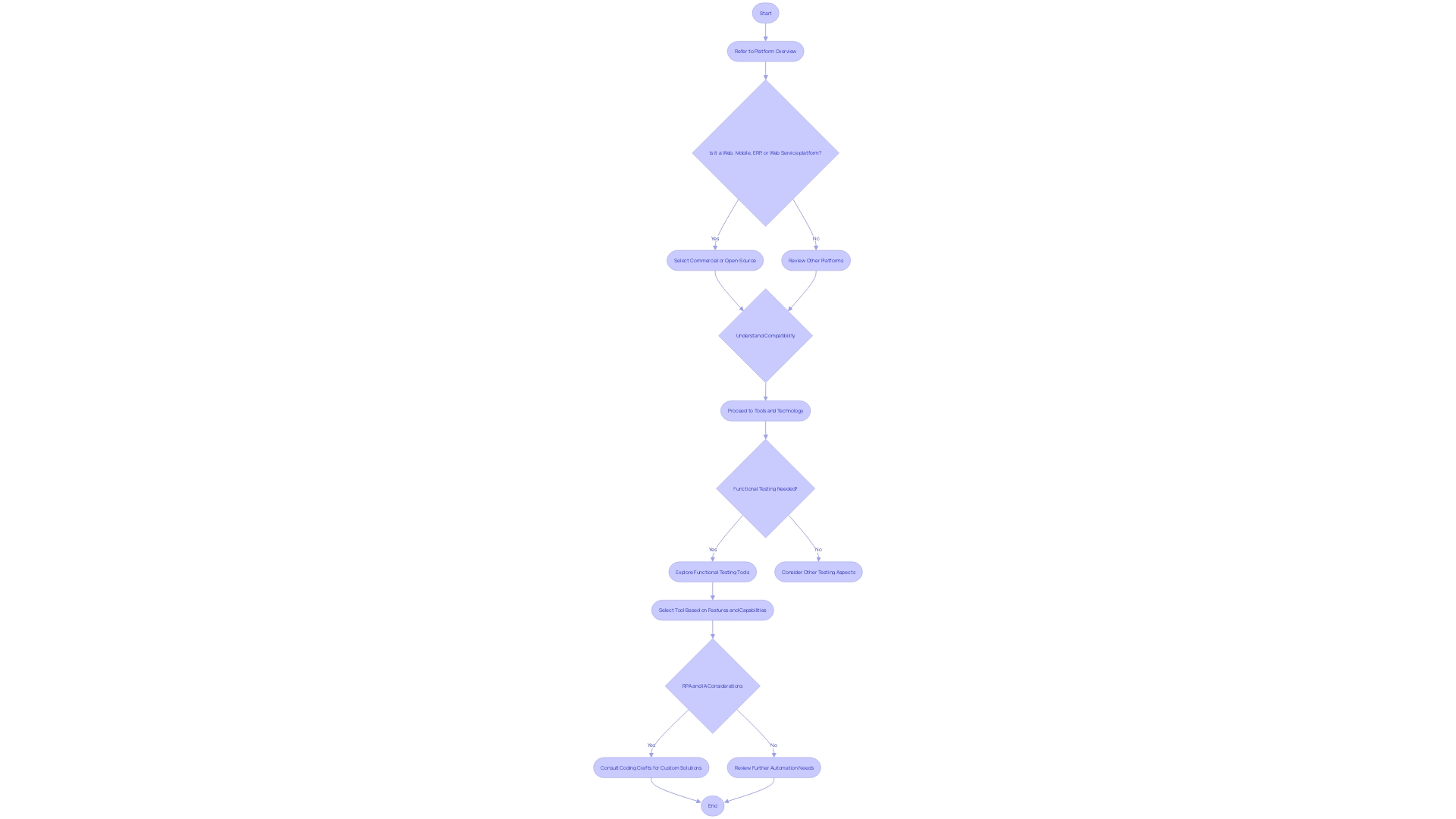
Step-by-Step Guide to Becoming an RPA Developer
Embarking on a career as an RPA developer is an exciting journey filled with opportunities for growth and innovation. To begin, immerse yourself in the foundational concepts and advantages of RPA, ensuring a robust base of knowledge. Programming expertise is crucial; sharpen your skills in languages like Python or Java, and delve into automation and scripting.
Hands-on practice is next: delve into RPA tools such as UiPath and Automation Anywhere, exploring their capabilities. UiPath’s Citizen Developer Foundation training, for example, provides an immersive learning experience with practical exercises spanning multiple industries. Certifications are a testament to your proficiency; obtaining them from esteemed bodies adds to your professional stature.
Real-world application of your skills comes from collaborating on RPA projects. Here, you can learn from seasoned experts and apply your knowledge in practical settings. For instance, consider how the team at Delivery Hero streamlined their IT processes, or how Lindy integrated a network of apps for their AI assistants, showcasing the transformative power of RPA in action.
Keeping abreast of industry trends is pivotal. The rapid technological advancements and the need for RPA professionals to stay informed underscore Epic and Cerner’s dominance in the electronic health records space. Engage with webinars and workshops, and network with peers through platforms like LinkedIn. Connections in this field can lead to insights and career advancement opportunities.
Remember, certifications, while debated, are still valued in the tech industry, as evidenced by software professionals often being encouraged to pursue them. They signify a commitment to your craft and can elevate your appeal to potential employers. As you develop your career, remember to look at big-picture industry trends, such as the job market data for tech and healthcare sectors, to gauge opportunities and align your skills accordingly.
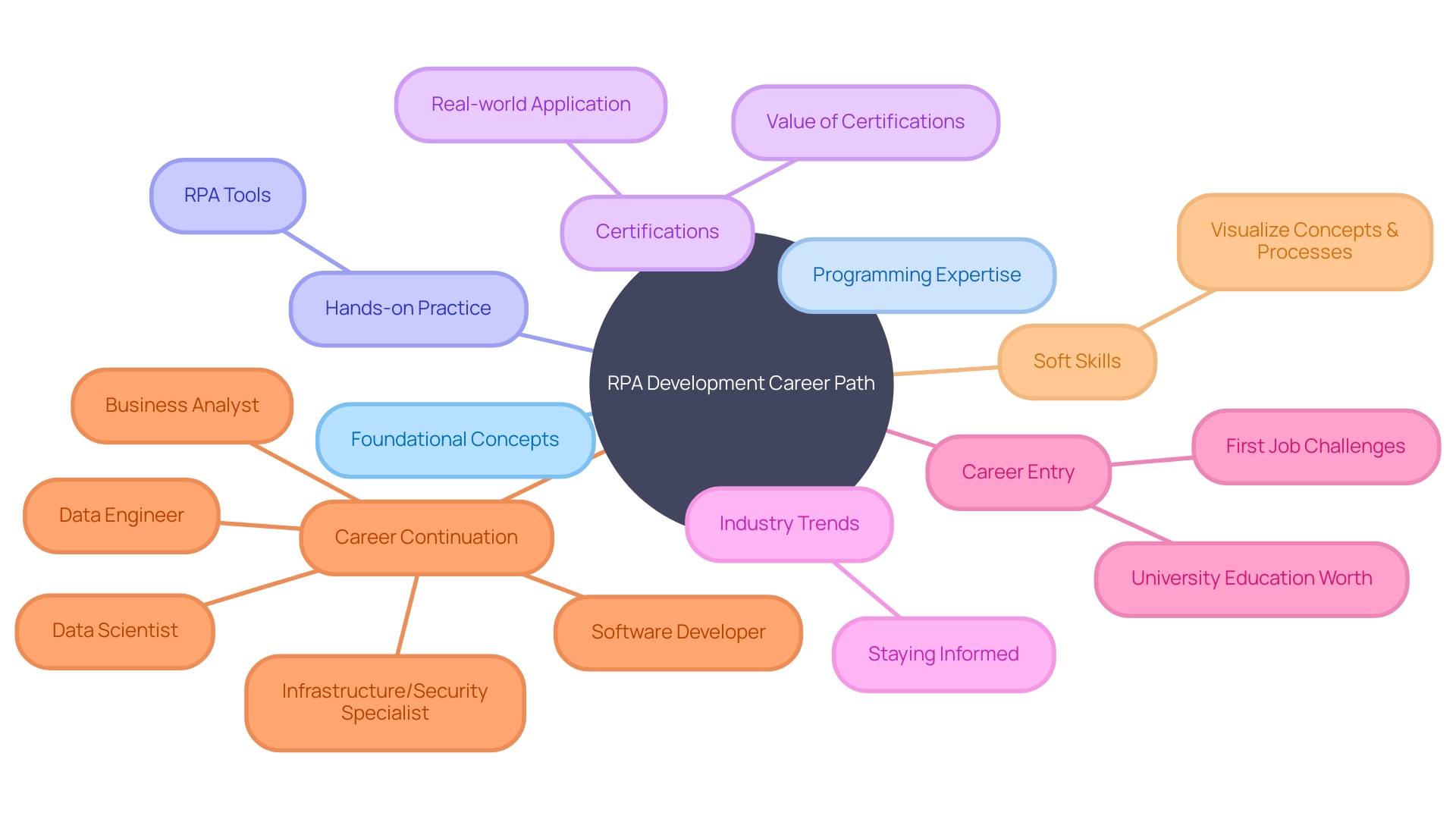
Understanding the Role of an RPA Developer
-
Analyzing Business Processes: An RPA professional must delve deeply into existing business processes, similar to how the Digital Service Team conducts initial assessments to ensure the requested technology aligns with security and compliance standards. By taking this approach, an RPA professional reveals areas ready for streamlining, aligning with stakeholders’ requirements and identifying potential that may already exist within the organization.
-
Designing Automation Solutions: The design phase is critical, akin to the NHS’s approach to assessing whether a technology is appropriate for its intended use. RPA experts create precise solutions, guaranteeing their resilience, precision, and achievement of the desired outcomes, similar to how healthcare facilities must ensure their technologies address specific issues.
-
Testing and Debugging: RPA professionals rigorously examine and debug the solutions to ensure they function properly and meet the specified criteria. Reflecting the feeling of the CTO of Reveille Software, it’s comprehended that automation is not a set-and-forget procedure; it necessitates continuous adjustments and troubleshooting to uphold stability.
-
Deployment and Maintenance: Once developed, RPA solutions are deployed and must be maintained to ensure their continued effectiveness. This mirrors the need for constant monitoring and management of automated systems throughout history, underscoring that RPA is not exempt from the need for human oversight.
-
Collaboration and Communication: Effective communication is paramount for RPA developers, as they must work in concert with various stakeholders. This is comparable to the collaborative nature of digital technology assessments, where multiple parties contribute to the decision-making procedure.
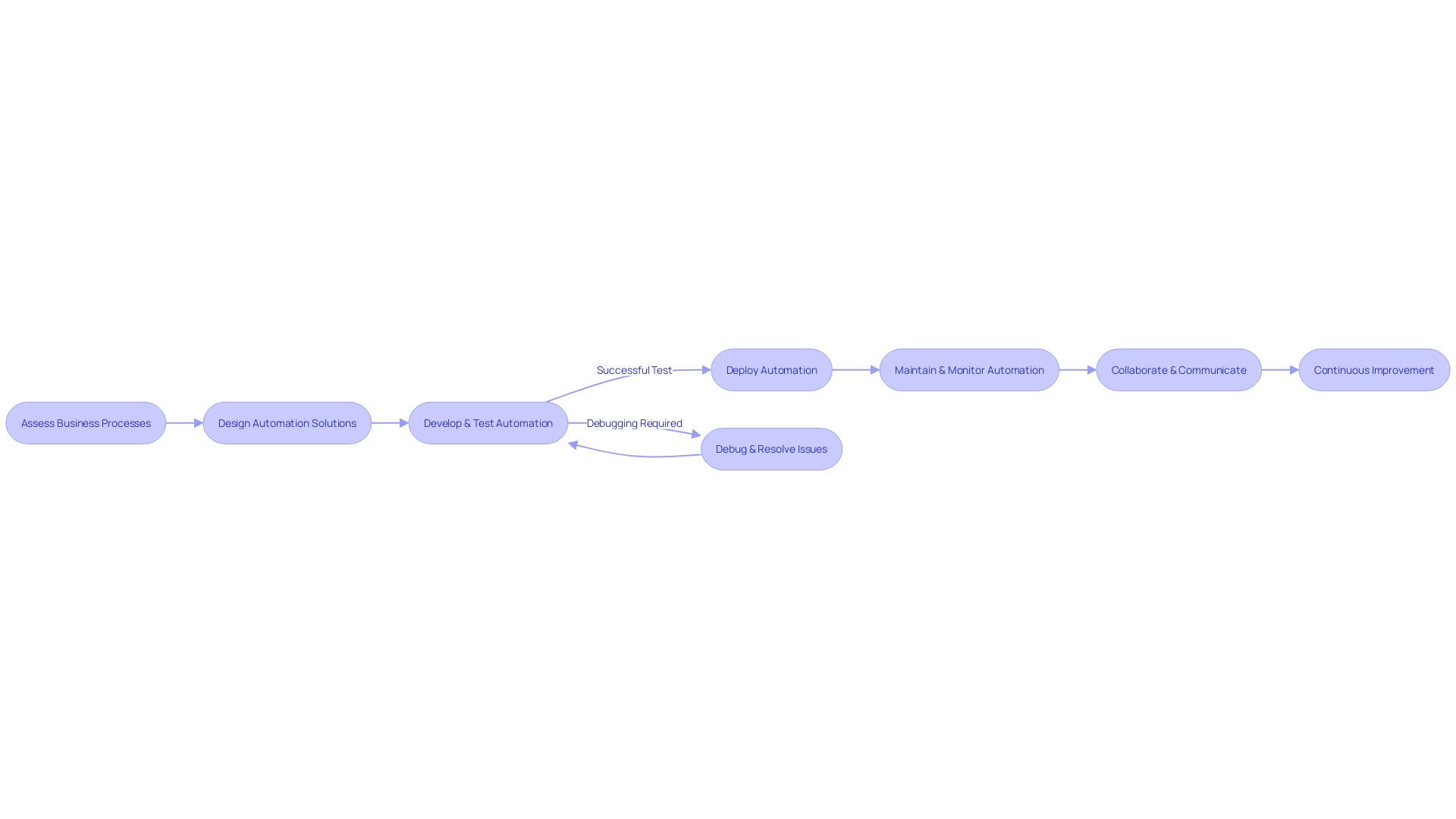
Best Practices in RPA Development
To enhance the success of projects, adhering to RPA development best practices is crucial. Establishing uniform procedures prior to implementing automated systems guarantees thorough documentation, resulting in enhanced efficiency during execution and upkeep. By designing RPA solutions to be modular, developers can facilitate easy updates and scalability, adapting to evolving business needs.
Incorporating robust error handling mechanisms is essential for smooth execution and handling exceptions. Version control systems, like Git, are essential for managing modifications in scripts, enabling smooth collaboration and the capability to roll back to previous versions when needed.
Ensuring security is of utmost importance when automating tasks that involve sensitive data. It is necessary to implement measures that protect this data and comply with privacy regulations. Moreover, continuous testing and maintenance are vital for addressing issues and improving performance, ensuring the RPA solutions function optimally.
Finally, thorough documentation of the mechanization solutions, including process flows, design decisions, and troubleshooting steps, is essential for future reference and knowledge transfer, making it easier for others to comprehend and operate with the system.
By adopting these proven methods, RPA developers can build more dependable, expandable, and protected solutions that endure and promote operational superiority.
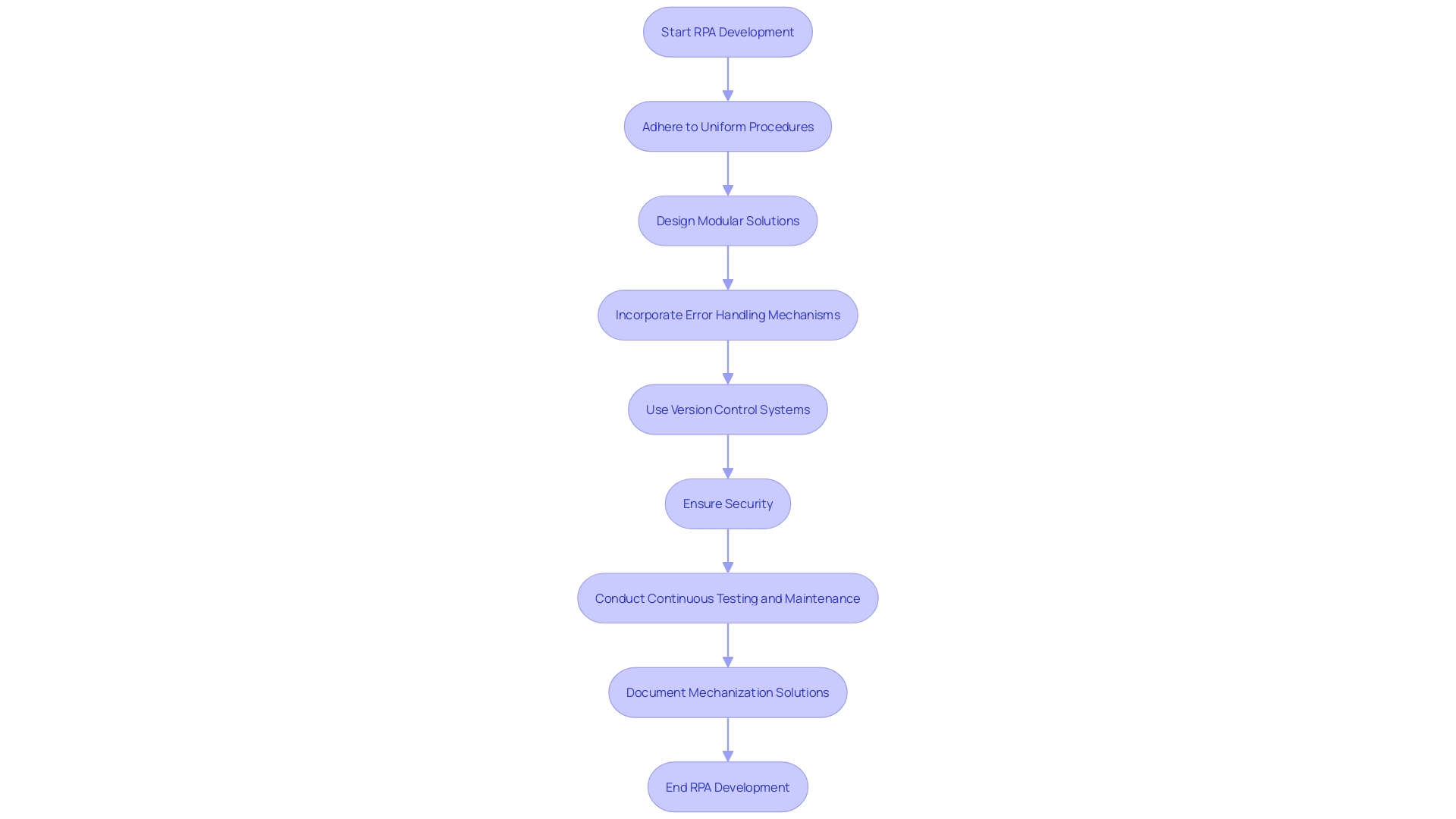
Advanced RPA Techniques
Exploring the advanced methods of RPA development can reveal new levels of efficiency and intelligence. Here’s a look at some of the sophisticated strategies that can take your automation capabilities to the next level:
-
Cognitive Automation: This approach elevates RPA by infusing it with AI capabilities like natural language processing and machine learning. The outcome is a system that can handle unstructured data and make intelligent decisions, similar to the Digital Service Team’s evaluation procedure for new technology requests, ensuring security, compliance, and appropriateness.
-
Intelligent Automation (IA): Through the integration of RPA with AI and machine learning, IA can manage intricate business procedures that necessitate decision-making and problem-solving. For example, Medien Hub Bremen-Nordwest experienced significant customer service improvements by implementing an AI platform, leading to faster complaint processing times.
-
Orchestrator: An RPA orchestrator acts as a nerve center for your efforts, offering features such as scheduling, logging, and analytics to manage and monitor your solutions effectively.
To improve your scripts, advanced scripting methods that involve variables, loops, conditionals, and exception handling can optimize and streamline your tasks.
Understanding the process of integrating APIs can enable smooth data exchange and streamline processes across various platforms, as demonstrated in the partnerships between technology partners and companies such as GrayMatter Robotics.
Utilize tools to analyze the performance and effectiveness of your automated solutions. This insight can identify improvement areas and lead to data-driven decisions, echoing the sentiments of professionals who contribute to the State of the automated industry report.
By embracing these advanced RPA techniques, organizations can not only improve their operational efficiency but also gain a competitive edge in the rapidly evolving technological landscape.
Managing Organizational Change with RPA
When considering the implementation of Robotic Process Automation (RPA) within your organization, it is crucial to address organizational change with a strategic approach. Engaging stakeholders early is vital. By involving key personnel from the outset, you can preemptively tackle concerns, ensuring RPA aligns with the organization’s goals and vision.
To foster acceptance, clear communication regarding RPA’s benefits and impact is essential. Training programs should be crafted to provide employees with skills necessary for adapting to automation-enhanced workflows.
Selecting change champions within the organization can be an effective tactic. These individuals advocate for RPA, helping to mitigate resistance and address employee apprehensions. Implementing RPA in phases allows for smoother adaptation and minimizes operational disruptions. This phased approach mirrors the journey of a leading Chilean retailer who, upon rapid expansion, faced challenges in managing their growing workforce. They acknowledged the necessity to develop their talent management methods in order to uphold their status as a leading employer for technologists.
Providing continuous support and guidance throughout the RPA transition is another key strategy. This ensures that any productivity impacts are addressed promptly, maintaining operational continuity.
Finally, assessing the effectiveness of RPA deployment and commemorating accomplishments act as strong affirmations of the positive impacts of the implementation. As per insights from industry experts, while the path to embracing new technologies like RPA can be challenging, particularly for large organizations with legacy systems, the journey is essential for staying competitive in a rapidly evolving market. In fact, research indicates that nearly 80% of enterprises need to adapt every two to five years to thrive, underlining the imperative of organizational agility. By following these strategic steps, your organization can effectively manage the change that comes with RPA, reaping its full benefits for enhanced efficiency and productivity.
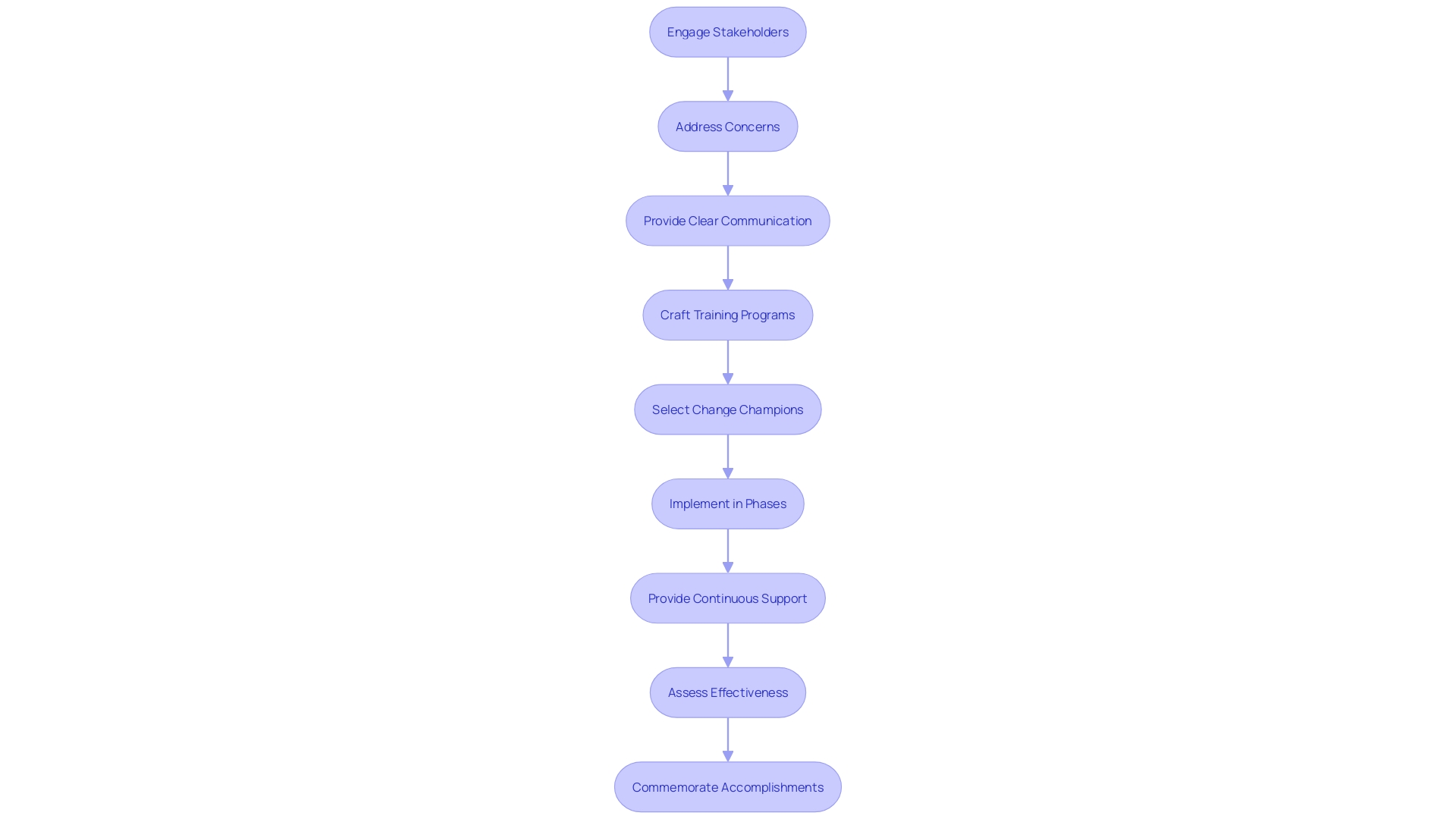
Governance and Compliance in RPA
When integrating Robotic Process Automation (RPA) into your organization, it is crucial to ensure that your initiatives are in line with governance and compliance standards. To navigate this landscape effectively, consider the following strategies:
-
Data Privacy and Security: To comply with regulations like GDPR or HIPAA, deploy robust measures to safeguard sensitive information. This includes encryption, secure data storage, and regular security assessments.
-
Audit Trails: Keep a meticulous record of all RPA activities. Document interactions between users and systems, as well as any data modifications. These records are essential for compliance verification and operational oversight.
-
Change Management: Develop a structured method for documenting amendments to RPA scripts. This promotes transparency and helps maintain accountability throughout the automation lifecycle.
-
Access Controls: Leverage role-based access systems to regulate who can use certain RPA tools and scripts. This approach is key to preventing unauthorized access and protecting data integrity.
-
Documentation and Reporting: Maintain a thorough archive of RPA processes, including workflows, decision logic, and compliance obligations. Regular reporting can validate adherence to regulations and pinpoint opportunities for optimization.
Equip RPA professionals and stakeholders with knowledge of compliance standards and best practices. An informed team is your first defense against compliance risks.
These elements not only address regulatory demands but also reinforce the security and reliability of your RPA framework, making your journey towards digital transformation more secure and sustainable.
Continuous Learning and Staying Updated
To maintain a competitive edge as an RPA developer, it’s vital to regularly update your knowledge and skills in this dynamic field. Here’s how:
- Community Engagement: Dive into RPA forums and social media groups. Engaging with peers allows you to exchange insights and stay abreast of the latest industry developments.
- Educational Events: Seek out webinars and workshops led by RPA experts. Such events are a goldmine for learning about new advancements and established best practices.
- Online Courses: Embrace the wealth of RPA courses and certifications available online. These can help refine your skills at your own pace.
- Industry Literature: Keep up with RPA-related blogs and reports. They can be a source of new ideas, successful case studies, and industry benchmarks.
- Tool Exploration: Dedicate time to experiment with emerging RPA tools. Hands-on practice can enhance your understanding of the latest technologies.
When considering RPA implementation, thorough assessment is key. You should identify the specific manual tasks that are ready for streamlining, uncover areas of inefficiency, and evaluate the costs associated with integration. For instance, within healthcare settings such as the NHS, a rigorous ‘digital-assurance process’ ensures new technologies meet stringent standards before adoption, leading to more effective digitization.
Meanwhile, emerging AI applications in sectors like UK public transportation show promise in boosting safety and efficiency but also highlight the importance of addressing ethical and privacy concerns.
For those in the industry, the recent ‘State of the Automation Professional Report’ reveals insights into the experiences of professionals in this field, including their job satisfaction and the growing intersection of artificial intelligence with their work. This data underscores the importance of continuous learning and adaptability in the rapidly advancing landscape of RPA.
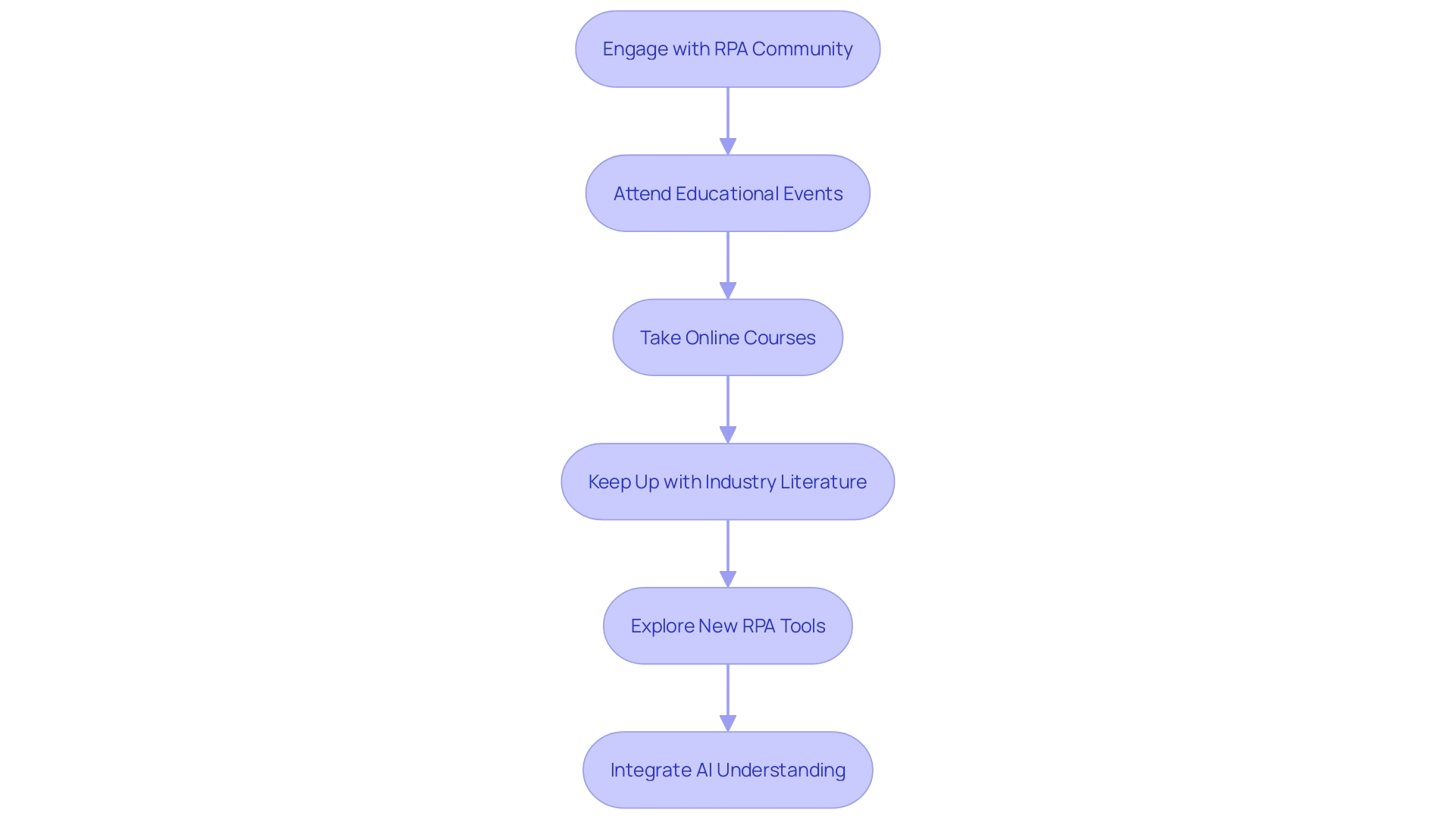
Building a Career as an RPA Developer
To establish yourself as a leading RPA developer, the key lies in blending technical prowess, industry knowledge, and a forward-thinking approach. Continuous self-improvement is critical; immerse yourself in the latest RPA tools and programming languages and commit to lifelong learning to keep your skills sharp and relevant.
Networking cannot be overstated; forge connections with fellow RPA experts, participate in industry gatherings, and engage in online forums. Such relationships can unlock new prospects and foster valuable collaborations.
Demonstrate your expertise through a well-crafted portfolio that displays your automation projects. Whether through case studies, live demos, or repositories on platforms like GitHub, let your work speak for itself.
Professional certifications are more than just accolades; they affirm your skills and bolster your presence in the competitive job market. Pursue certifications from esteemed organizations to stand out.
Adopt a philosophy of continuous improvement. Solicit feedback, learn from each project, and always aim to enhance your competencies. Staying adaptable and eager to learn will help you navigate the dynamic landscape of RPA.
RPA’s versatility across industries offers a unique opportunity to diversify your experience. Delve into various sectors to understand different business processes and how RPA can optimize them. Whether it’s using AI to manage a fleet of virtual digital assistants or employing Power Platform solutions to streamline data entry at mining sites, your ability to apply RPA creatively will set you apart.
As the robotics industry evolves, with a notable dip in sales following record highs, staying ahead means understanding the delicate balance between automating tasks and the irreplaceable value of human skills. Embrace the interplay between human and digital workforces to unleash full potential.
Remember, your career trajectory should not be left to chance. Start with the end in mind, mapping out the steps to your ultimate career goal. Analyze the paths of those who have succeeded before you, learning from their complete career narratives, including their trials and triumphs.
In this journey, data analysis skills are indispensable. Data analysts are the navigators of the tech world, their insights crucial to strategic decisions. The demand for these skills spans industries, with tech, healthcare, and retail leading the hiring trend.
In conclusion, your career as an RPA developer is a canvas. Paint it with continuous learning, professional networking, showcasing achievements, certifications, and an improvement-driven mindset. With this strategy, you will not only adapt to the industry’s currents but also steer your career towards success.
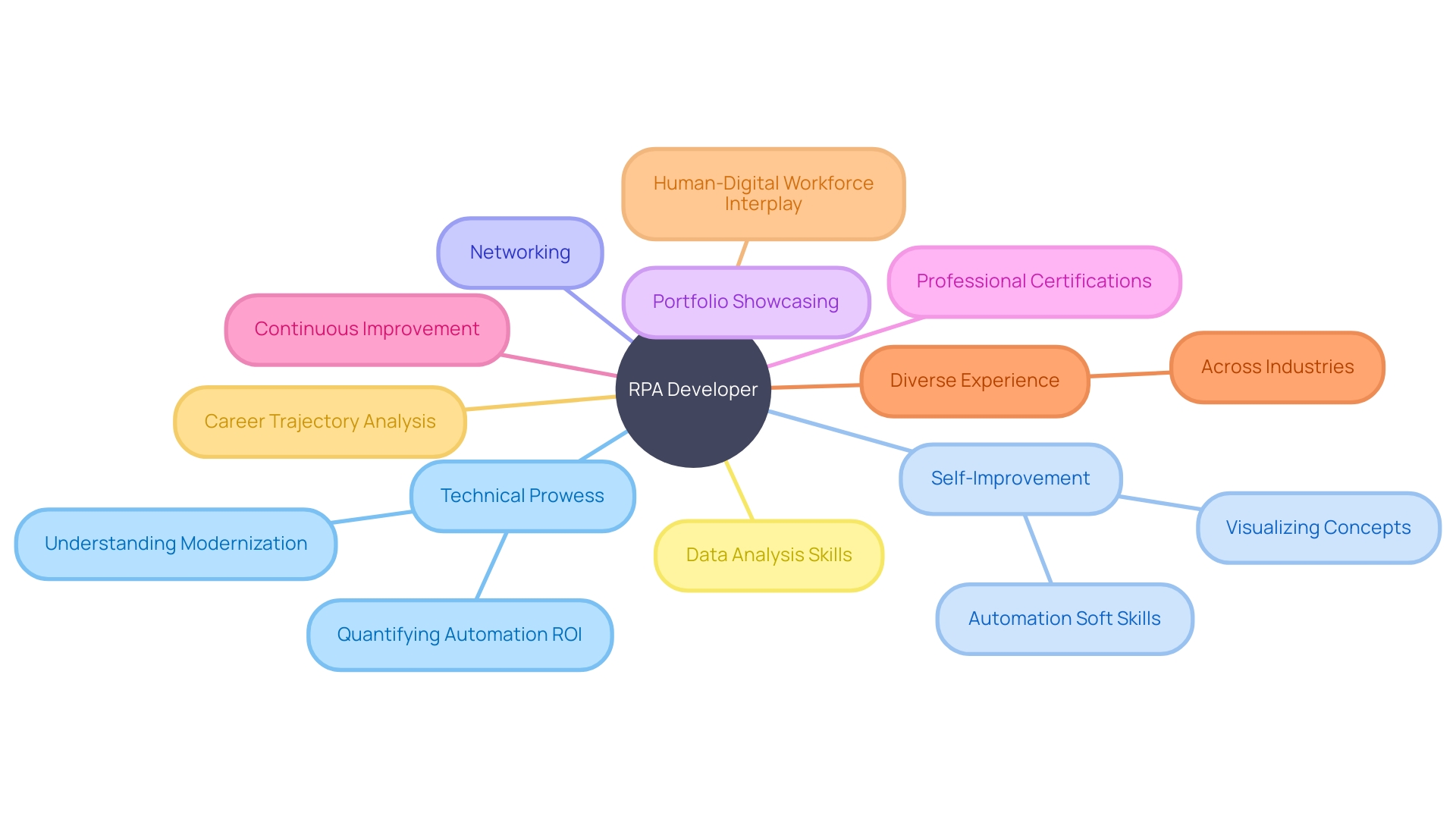
Conclusion
In conclusion, a career as an RPA developer offers numerous benefits and growth opportunities. RPA developers play a crucial role in driving business optimization and innovation through automated systems. With a commitment to continuous learning, RPA developers can master the tools that shape the future of automation.
Choosing the right RPA tools is essential for successful automation initiatives. Factors like functionality, scalability, ease of use, integration capabilities, and vendor support should be considered.
To become an RPA developer, focus on foundational concepts, programming languages, and hands-on practice. Collaboration on real-world projects and staying updated on industry trends through community engagement are crucial for professional growth.
Adhering to RPA development best practices, such as standardizing processes, designing modular solutions, and ensuring data privacy and security, can elevate the success of automation projects.
Advanced RPA techniques, such as cognitive automation and intelligent process automation, unlock new levels of efficiency and intelligence in automation, providing a competitive edge.
Managing organizational change with a strategic approach is crucial for successful RPA implementation. Engaging stakeholders, clear communication, and phased implementation are key strategies.
Ensuring governance and compliance in RPA initiatives is essential. Data privacy and security measures, audit trails, and documentation support compliance standards.
Continuous learning and staying updated through community engagement and educational events are vital for maintaining a competitive edge as an RPA developer.
Building a successful career involves continuous self-improvement, networking, showcasing achievements, and obtaining professional certifications.
In conclusion, a career as an RPA developer offers immense potential for growth and innovation. By embracing continuous learning, adhering to best practices, and staying updated on industry trends, RPA developers can navigate the dynamic landscape and steer their careers towards success.

